A well-thought-out plan can make a difference when designing your indoor garage lighting. While artificial lighting has its merits, incorporating natural light into your garage design can elevate the overall aesthetic and functionality of the space.
Natural light has numerous benefits, including improved mood, energy efficiency, and reduced electricity consumption. By harnessing the power of sunlight, you can create a welcoming and well-lit garage that serves multiple purposes.
So, how can you incorporate natural light into your garage design? Here are some design tips to help you make the most of this valuable resource.
1. Install windows: Adding windows to your garage is one of the most effective ways to let natural light flood in. Position them strategically to maximize the amount of sunlight during different times of the day.
2. Skylights: If windows aren’t feasible, consider installing skylights. These rooftop windows bring abundant natural light and create an open, airy atmosphere in your garage.
3. Glass doors: Opting for glass garage doors is another excellent way to incorporate natural light. Their transparent panels allow sunlight to filter through, illuminating the space while providing a sleek and modern look.
4. Light shelves: Installing light shelves above windows can help redirect natural light deeper into your garage. They bounce sunlight off their reflective surface, brightening the entire space.
5. Light-reflective surfaces: When selecting materials for your garage, choose light-reflective surfaces. This includes light-colored walls, floors, and ceilings, which will help distribute natural light evenly throughout the space.
By incorporating natural light into your garage design, you can transform a dark and gloomy space into a bright and inviting one. Not only will this improve your overall garage experience, but it will also positively impact your energy consumption and well-being.
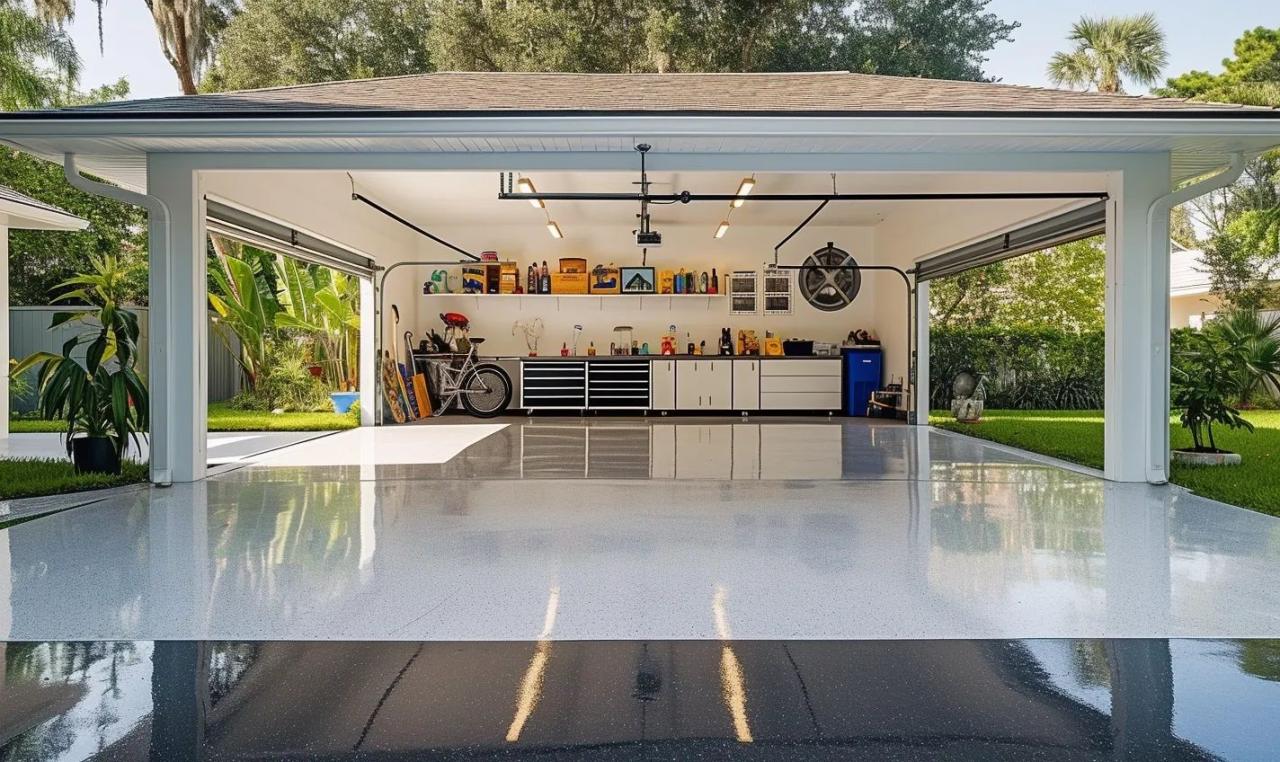
Incorporating Natural Light into Your Garage
Incorporating natural light can significantly affect the space’s aesthetics and functionality when designing your indoor garage lighting. Natural light brightens your garage and offers several benefits that can enhance your overall experience.
Enhances Visibility
Having ample natural light in your garage can significantly improve visibility, making navigating and finding items easier. This is especially important if you use your garage as a workshop or storage area. Using natural light minimizes the need for artificial lighting during the day, saving energy costs and creating a more comfortable environment.
Creates a Welcoming Atmosphere
Natural light can transform any space into a warm and welcoming environment. Incorporating this light into your garage can make the space feel more inviting, whether you spend much time there or enter and exit your vehicle. It creates an ambiance that is both uplifting and enjoyable.
Boosts Mood and Productivity
Exposure to natural light has been found to impact mood and productivity positively. The natural light helps regulate the body’s circadian rhythm, leading to better sleep patterns and improved overall well-being. Bringing natural light into your garage can create a more uplifting and energizing environment, making it a pleasant place to work or spend time.
Provides Health Benefits
Natural light is a rich source of vitamin D, essential for bone health and immune function. By incorporating natural light into your garage, you can benefit from exposure to this vitamin, improving your overall health and well-being. Spending time in a well-lit garage can also help reduce eye strain and headaches caused by inadequate lighting.
Enhances Safety and Security
Natural light can improve the safety and security of your garage. By allowing natural light to enter, you can see your surroundings, reducing the risk of accidents or tripping hazards. Additionally, natural light deters potential intruders, making your garage a less attractive target for theft or vandalism.
Incorporating natural light into your garage is not only a design choice; it also offers numerous benefits that can significantly enhance your overall garage experience. Natural light can transform your garage into a more functional and enjoyable space, from improving visibility and creating a welcoming atmosphere to boosting mood, productivity, and health benefits.
Ultimately, the decision to incorporate natural light into your garage will depend on various factors, such as the availability of windows, placement options, and overall design vision. However, by carefully considering these factors and utilizing the proper techniques, you can maximize the natural light in your garage and reap the rewards it provides.
Incorporating Natural Light into Your Garage
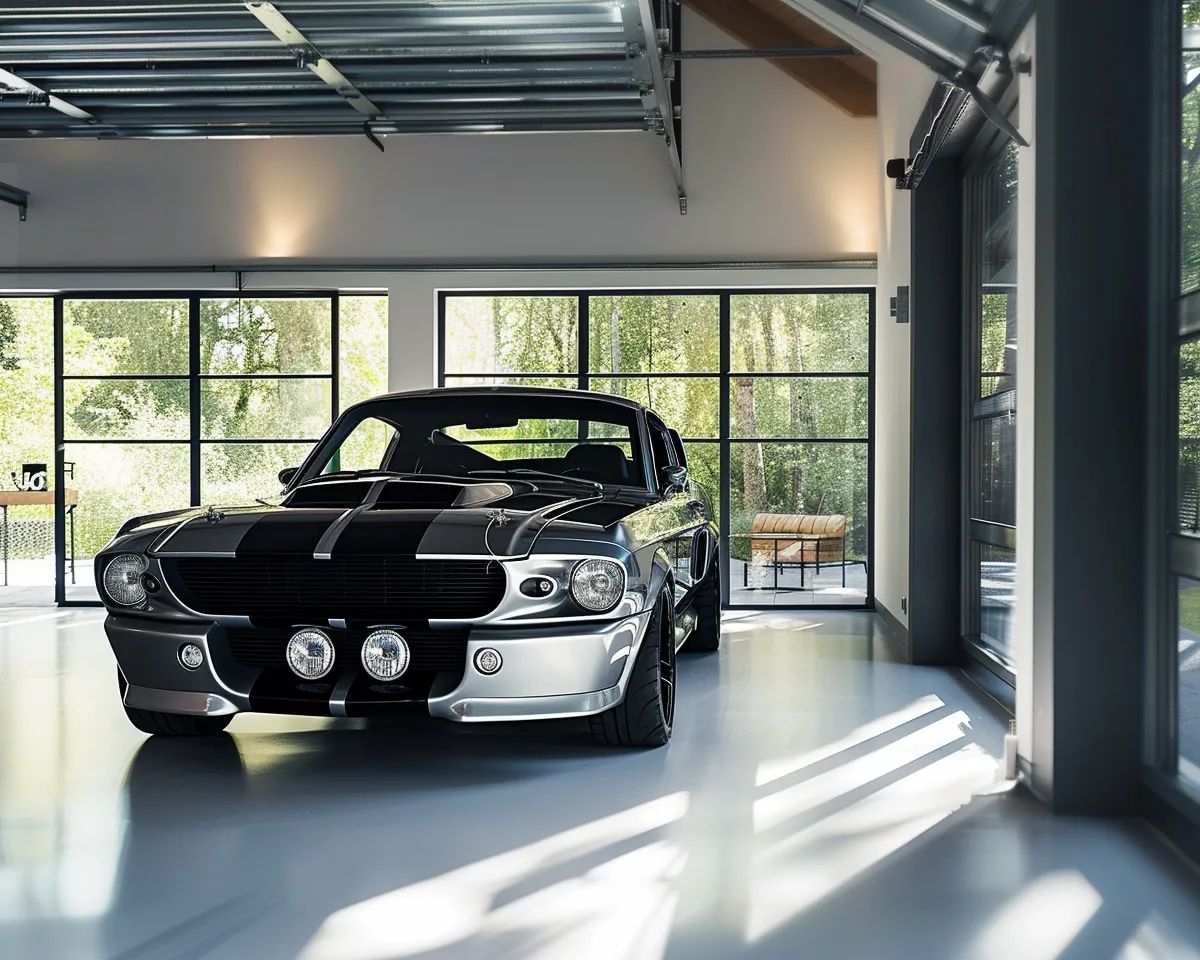
Incorporating natural light is an essential consideration when designing your indoor garage lighting. Natural light helps create a bright, inviting atmosphere and contributes to energy efficiency and well-being. Maximizing sunlight can create a functional and visually appealing garage space. Here are some practical tips on how to incorporate natural light into your garage:
Assessing Your Garage’s Natural Lighting Potential
To begin, evaluate the layout and structure of your garage to determine the areas that receive the most natural light throughout the day. This assessment will help you identify where windows or skylights can be strategically placed to maximize daylight.
Maximizing Daylight with the Right Window Placement
Consider the placement of windows to maximize the entry of natural light. Position them on the sides of your garage where the sun is most likely to enter. Opt for more oversized windows to allow ample sunlight to fill the space.
Choosing the Right Window Types for Your Garage
When selecting windows for your garage, choose those with energy-efficient features such as low-emissivity (low-E) glass. Low-E glass helps reduce heat loss in winter and solar heat gain in summer, ensuring a comfortable temperature in your garage throughout the year.
Enhancing Natural Light with Garage Door Windows
Another way to bring in natural light is by installing windows on your garage door. This can significantly brighten up the interior and provide a sense of spaciousness.
Utilizing Skylights to Bring in More Daylight
If your garage’s structure allows for it, consider installing skylights. These roof windows enable increased daylight penetration, especially when adding traditional windows is challenging.
Considerations for Optimal Garage Lighting
While natural light is important, it’s also essential to have adequate artificial lighting for your garage. Assess the areas and tasks that need sufficient illumination, such as workbenches, storage areas, or vehicle maintenance zones, and choose appropriate lighting fixtures to complement the natural light.
By incorporating these strategies into your garage design, you can create a well-lit and highly functional space while reducing reliance on artificial lighting during the day. Enjoy the benefits of natural light, enhance your productivity, and make your garage a more enjoyable place to be.
Remember, balancing the need for natural light and privacy or security concerns is essential. Consider selecting windows that offer privacy features or adding window treatments if desired. With careful planning and thoughtful design, you can transform your garage into a bright, inviting space that meets all your lighting needs.
Assessing Your Garage’s Natural Lighting Potential
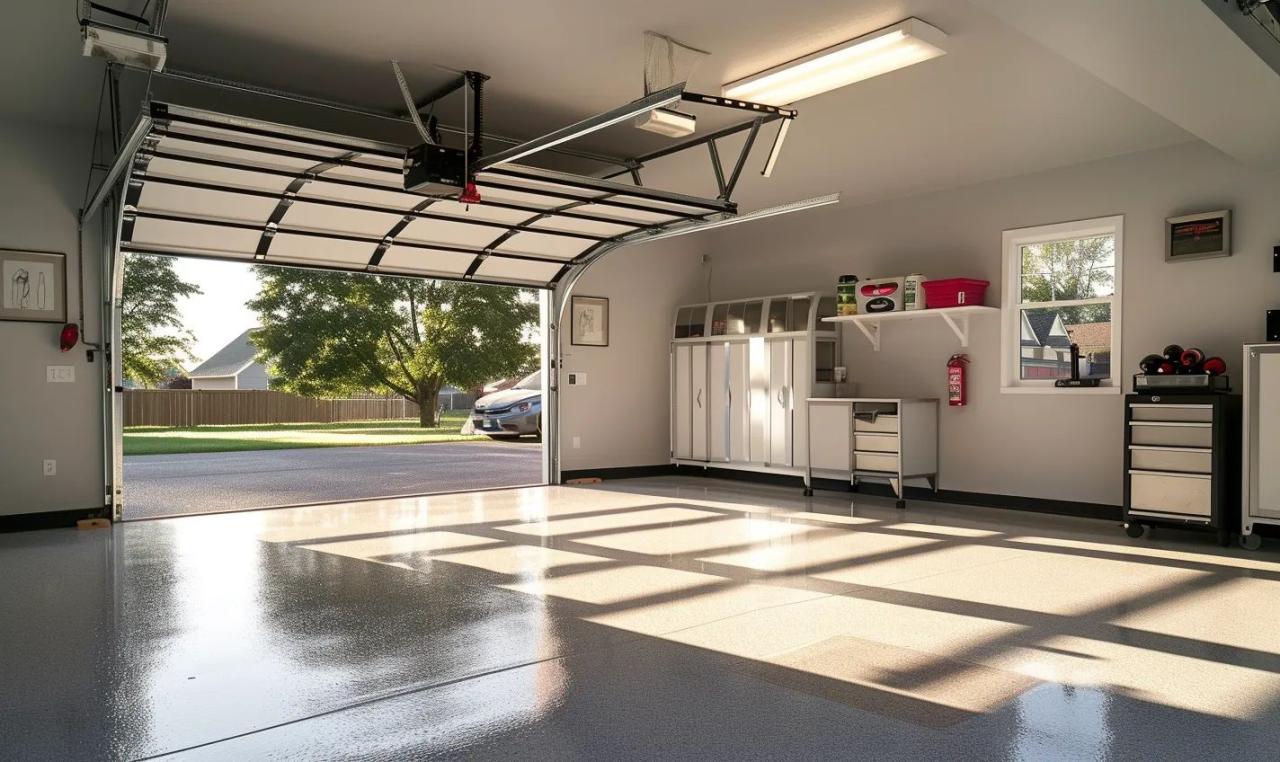
When designing your indoor garage lighting, one of the first steps is assessing your garage’s natural lighting potential. Incorporating natural light into your garage improves visibility and creates a more welcoming and pleasant environment. Here are some factors to consider when evaluating your garage’s natural lighting potential:
Sun Exposure
Start by observing the sun’s path throughout the day and identifying the areas of your garage that receive the most sunlight. Consider how the sun’s position changes with the seasons, as this can impact the availability of natural light. Take note of nearby structures or trees that may cast shadows on your garage.
Window Placement
Take a closer look at your garage’s current window placement. Are the windows strategically positioned to maximize natural light? Consider adding windows or enlarging existing ones in areas with the most sun exposure. Adding windows high up on the walls can also help bring in more light without sacrificing privacy.
Glass Types
Choosing the correct type of glass for your windows can significantly impact the amount of natural light entering your garage. Opt for clear or low-E glass, which allows more light to pass through while reducing glare and heat transfer.
Skylights
If your garage has a flat roof or a nearby area with a direct line of sight to the sky, installing skylights can be an excellent way to introduce natural light. Skylights bring in more sunlight and add a touch of elegance to your garage’s design.
Light Reflecting Surfaces
Consider incorporating light-reflecting surfaces into your garage’s design. Mirrors, light-colored walls, and glossy finishes can help bounce natural light around the space, making it feel brighter and more spacious.
Window Treatments
While maximizing natural light is essential, you also want control over privacy and glare. Consider installing window treatments such as blinds or curtains that allow you to adjust the light entering your garage while maintaining your desired level of privacy.
By carefully assessing your garage’s natural lighting potential and incorporating these design strategies, you’ll be well on your way to creating a garage filled with beautiful, energy-efficient natural light. Please make the most of this free resource and enjoy its many benefits!
Mixing Natural Light into Your Garage
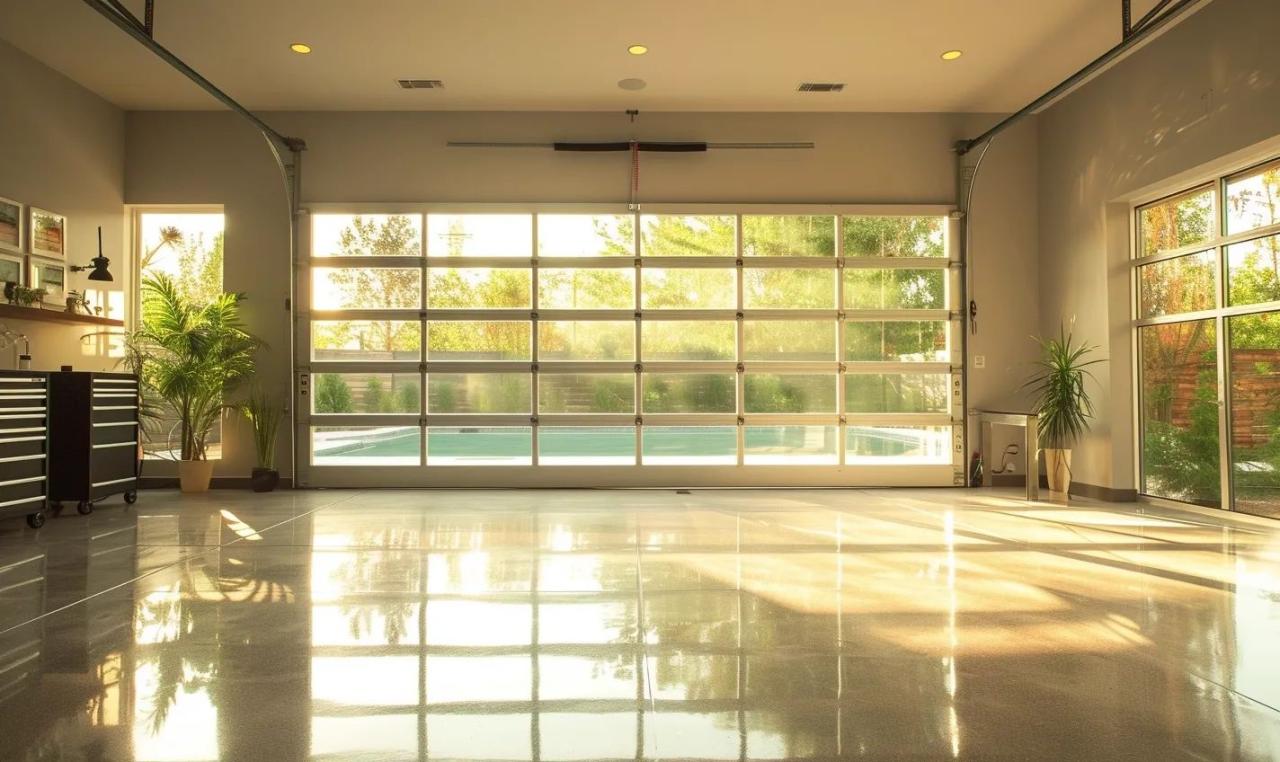
When designing your indoor garage, lighting is a crucial element often overlooked. Mixing natural light into your garage improves visibility and creates a more welcoming and pleasant environment. Natural light has many benefits, including reducing energy consumption, enhancing productivity, and improving mood and well-being.
Natural Light in Your Garage
Natural light provides a vibrant and dynamic source of illumination that cannot be replicated by artificial lighting alone. Its ability to mimic daylight creates a sense of spaciousness and depth, making your garage feel more extensive and open. Additionally, natural light helps to showcase the true colors of objects and materials, allowing you to see them in their most accurate form.
Assessing Your Garage’s Natural Lighting Potential
Before incorporating natural light into your garage, it’s essential to assess its natural lighting potential. Consider the orientation and layout of your garage to determine how sunlight enters the space throughout the day. Please take note of any existing windows or skylights that may already be in place and how they impact the overall lighting conditions.
Maximizing Daylight with the Right Window Placement
Strategic window placement is critical to maximizing daylight in your garage. Consider adding windows on your garage’s side or back walls to allow natural light to flood in. Placement near workbenches or areas where you spend the most time will ensure that you have ample light for your activities.
Choosing the Right Window Types for Your Garage
When selecting windows for your garage, opt for types specifically designed to maximize natural light. Consider using large, energy-efficient windows with low-E glass, allowing maximum light transmission while minimizing heat gain. Additionally, consider using windows with operable sections to increase ventilation and airflow.
Enhancing Natural Light with Garage Door Windows
If your garage has a large overhead door, incorporating windows into the door design is an excellent way to introduce natural light. Garage door windows come in various shapes and styles, such as rectangular or arched, and can be arranged in different patterns. They enhance the aesthetics and allow daylight to enter your garage.
You can transform natural light into a brighter, more inviting space by incorporating natural light into your garage. Consider options like window placement, windows, skylights, and reflective surfaces to create a well-lit and functional garage in which you’ll enjoy spending time.
Maximizing Daylight with the Right Window Placement
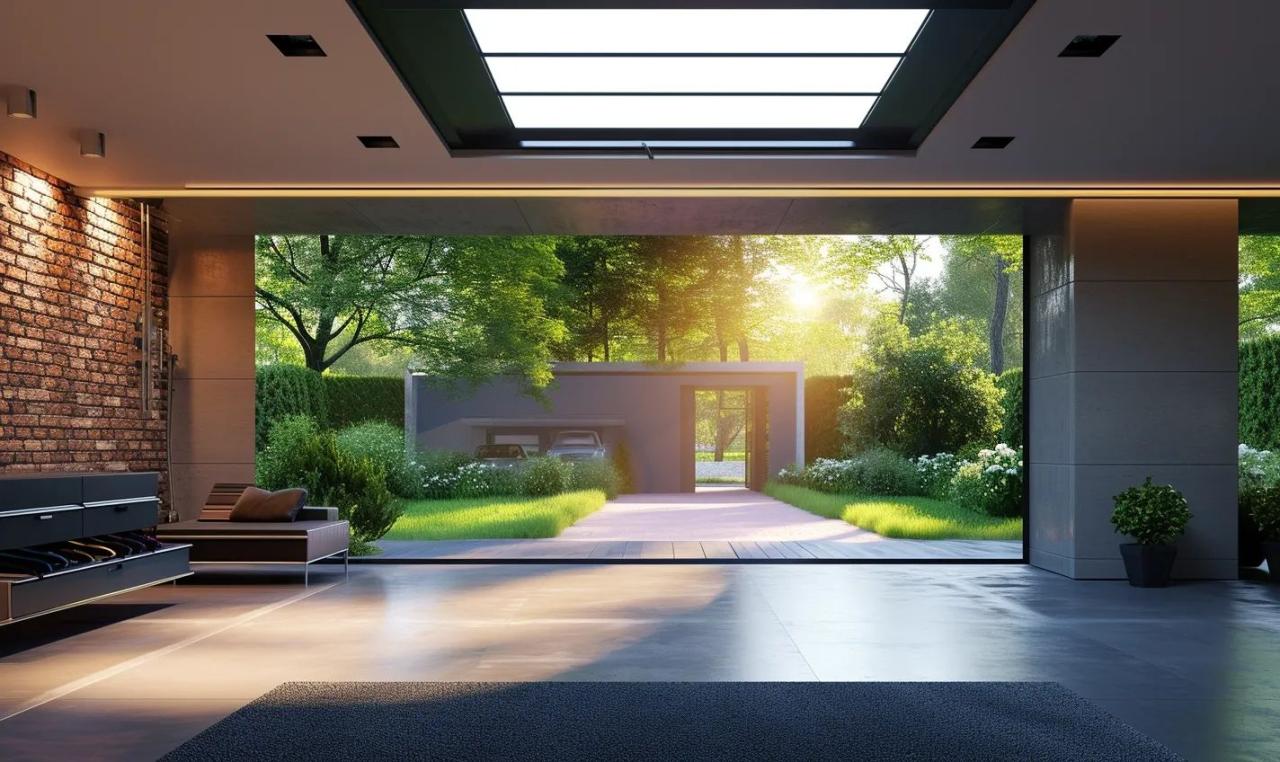
When incorporating natural light into your garage, strategically placing windows is one of the most effective ways. Maximizing daylight can create a brighter, more inviting, functional, and aesthetically pleasing space. Here are some tips on how to optimize window placement in your garage:
Assess the Sunlight’s Path
Before deciding on the placement of your garage windows, it’s essential to understand the path of sunlight throughout the day. Take note of where the sun rises and sets in your garage. Doing so lets you determine the optimal window locations to capture the most natural light.
Aim for South-Facing Windows
In regions with a moderate climate, south-facing windows receive the most sunlight throughout the day. By prioritizing the placement of your windows towards the south, you can maximize the amount of natural light that enters your garage. This will help reduce the need for artificial lighting during the daytime.
Consider the Surrounding Structures
Consider the proximity of other buildings, trees, or tall structures that may obstruct the flow of natural light into your garage. Be mindful of potential shading to ensure your windows receive ample sunlight. You can avoid unnecessary shadows and maintain a well-lit environment by choosing the proper window placement.
Opt for Larger Windows
The size of your garage windows also plays a crucial role in maximizing daylight. More oversized windows allow more natural light to enter, creating a brighter and more open space. Consider installing windows that span a significant portion of the wall to optimize the sunlight that illuminates your garage.
Include High Windows
In addition to traditional windows at eye level, incorporating high windows near the roofline can be beneficial. These windows can capture sunlight from different angles, especially during early morning or late afternoon when the sun is lower in the sky. Combining high and low windows will create a more evenly lit garage space throughout the day.
By strategically placing windows in your garage, you can harness the power of natural light to transform your space. This will enhance the overall aesthetics and provide functional benefits such as reducing the reliance on artificial lighting and creating a more pleasant working environment.
Stay tuned for the next blog post to discuss the windows ideal for maximizing natural light in your garage.
More Natural Light in Your Garage
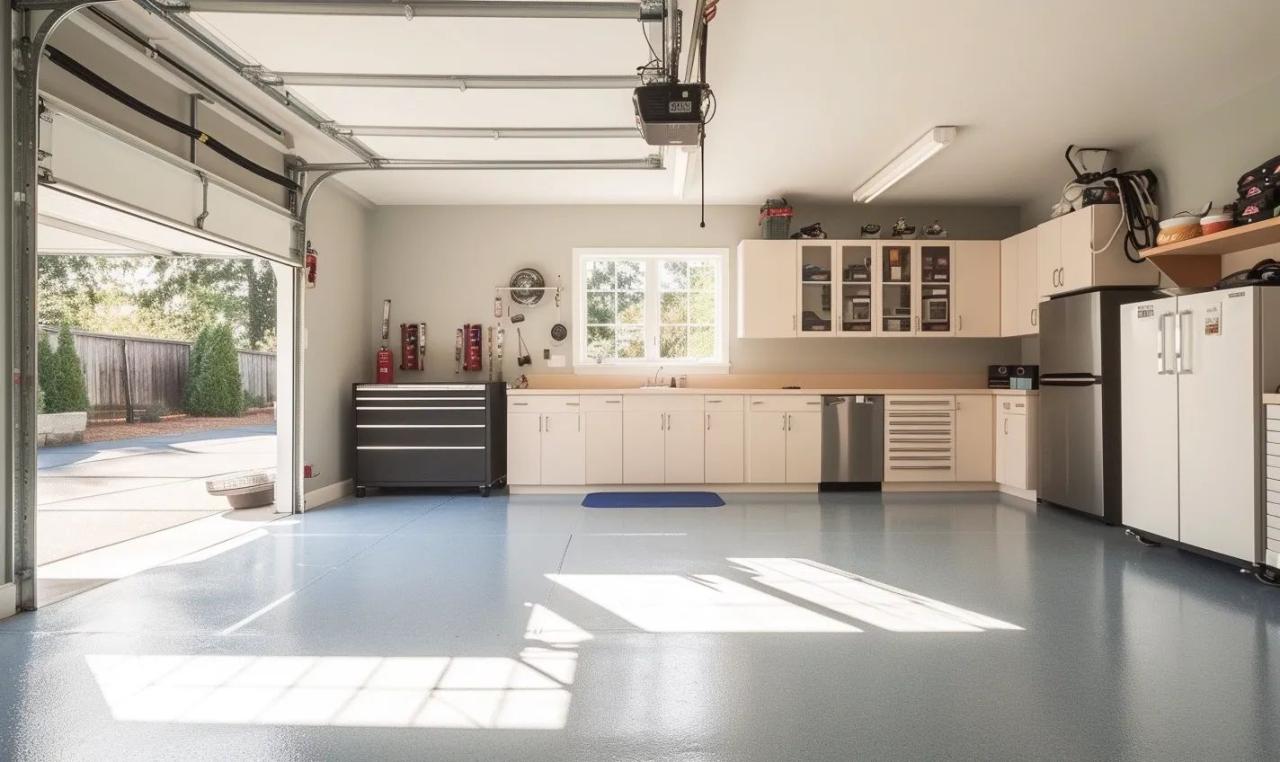
Natural light should be a top priority when designing your indoor garage lighting. Natural light not only improves the aesthetics of your garage but also offers numerous practical benefits. From enhancing visibility and reducing energy consumption to creating a more inviting space, natural light can transform your garage into a functional and comfortable area.
Importance of Natural Light in Your Garage
Natural light provides a sense of openness and spaciousness to any indoor space, including your garage. It not only allows you to see better but also has a positive impact on your mood and well-being. Incorporating natural light into your garage creates a more pleasant environment that encourages productivity and creativity.
Assessing Your Garage’s Natural Lighting Potential
Before deciding on the best ways to incorporate natural light into your garage, assess its current lighting potential, identify the existing natural light sources, such as windows and skylights, and determine if any modifications or additions are needed to improve the lighting conditions.
Maximizing Daylight with the Right Window Placement
Strategic window placement is vital in maximizing the natural light in your garage. Consider placing windows where sunlight is most abundant and can penetrate deep into the space. Consider the orientation of your garage and the path of the sun throughout the day to optimize your window placement.
Choosing the Right Window Types for Your Garage
Selecting the right window types is crucial for effectively incorporating natural light into your garage. Install large, energy-efficient windows that offer unobstructed views and allow ample sunlight to flow into the space. Consider using double-glazed or low-E coated windows to minimize heat loss or gain and improve energy efficiency.
Enhancing Natural Light with Garage Door Windows
Glass panels or windows on your garage door can further enhance the natural light inside your garage. Garage door windows provide additional light and add visual interest and curb appeal to your home. Choose frosted or opaque glass if you prefer privacy without sacrificing natural light.
By incorporating natural light into your garage, you can create a brighter, more inviting space that offers functionality and beauty. Take advantage of the available natural light sources and consider adding windows or garage door windows to maximize the benefits of natural lighting. Your garage will become a well-lit area and a more enjoyable and inspiring place to spend time.
Choosing the Right Window Types for Your Garage
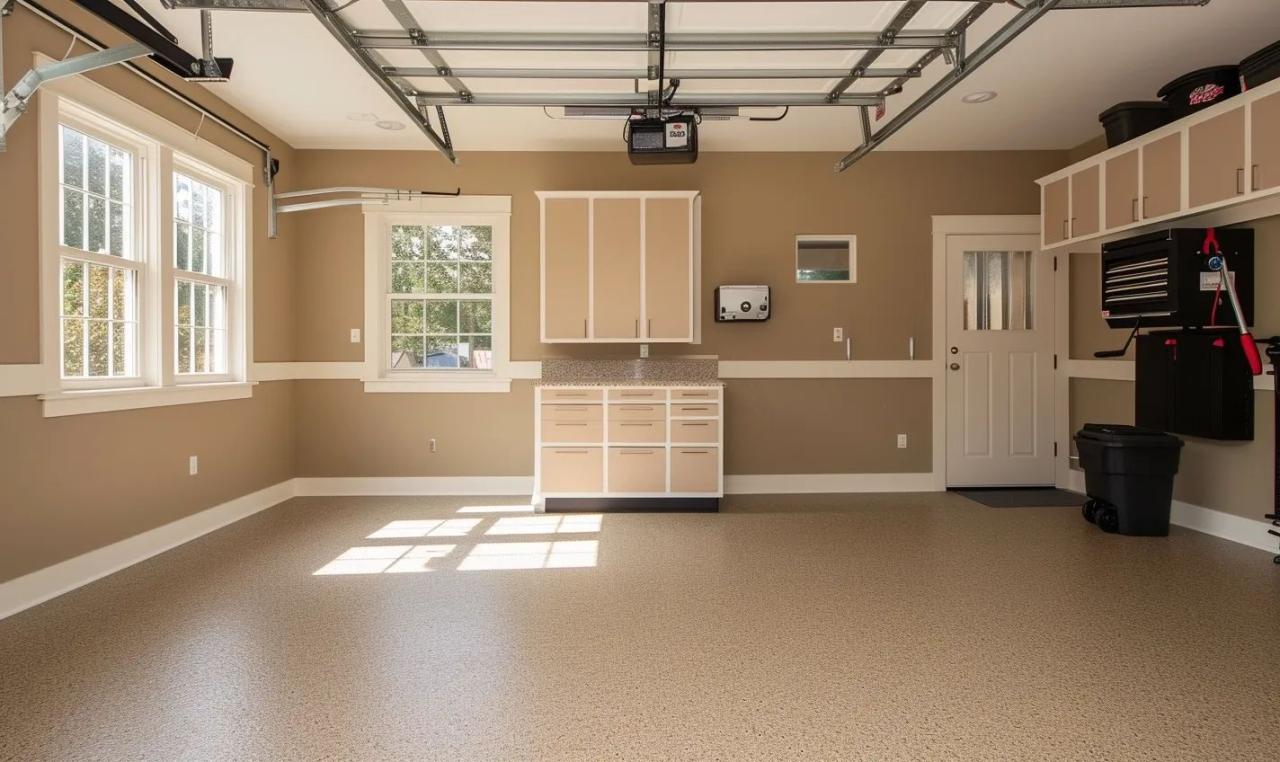
Letting Natural Light In
Choosing the right window types is crucial when incorporating natural light into your garage. The design and placement of windows can significantly impact how much sunlight enters the space, making it brighter and more inviting. Consider the following window options for your garage:
Single-Hung or Double-Hung Windows:
These windows are classic choices that provide versatility and functionality. Single-hung windows feature a movable bottom sash, while double-hung windows allow both sashes to open, providing better ventilation options for your garage. These windows are an excellent choice if you want to control the amount of fresh air and natural light that enters your space.
Casement Windows:
Casement windows open outward, like a door, with hinges on one side. They provide excellent ventilation and can be strategically placed to maximize the entry of natural light. Their unobstructed view, when opened, allows for a clear line of sight, making them a suitable option for garages that can benefit from increased visibility.
Picture Windows:
Picture windows are an excellent choice if you have a specific area in your garage that requires abundant natural light. These windows are large, fixed-pane windows that don’t open. They provide unobstructed views and maximize the sunlight entering your garage. However, since they don’t open, proper ventilation should be considered by incorporating other window types in conjunction with picture windows.
Choosing the right window types for your garage depends on insulation, durability, and security. Ensure that the windows you select are energy-efficient and can withstand the elements, protecting your garage and its contents.
Additionally, it’s worth considering the direction of sunlight and your garage’s location relative to your home. This will help you determine the best places to install windows, ensuring optimal sunlight throughout the day.
Remember, when selecting window types for your garage, it’s essential to balance natural light, ventilation, and security. In some cases, combining different window types may be the best approach to create an inviting and well-lit garage space.
Incorporating Natural Light into Your Garage
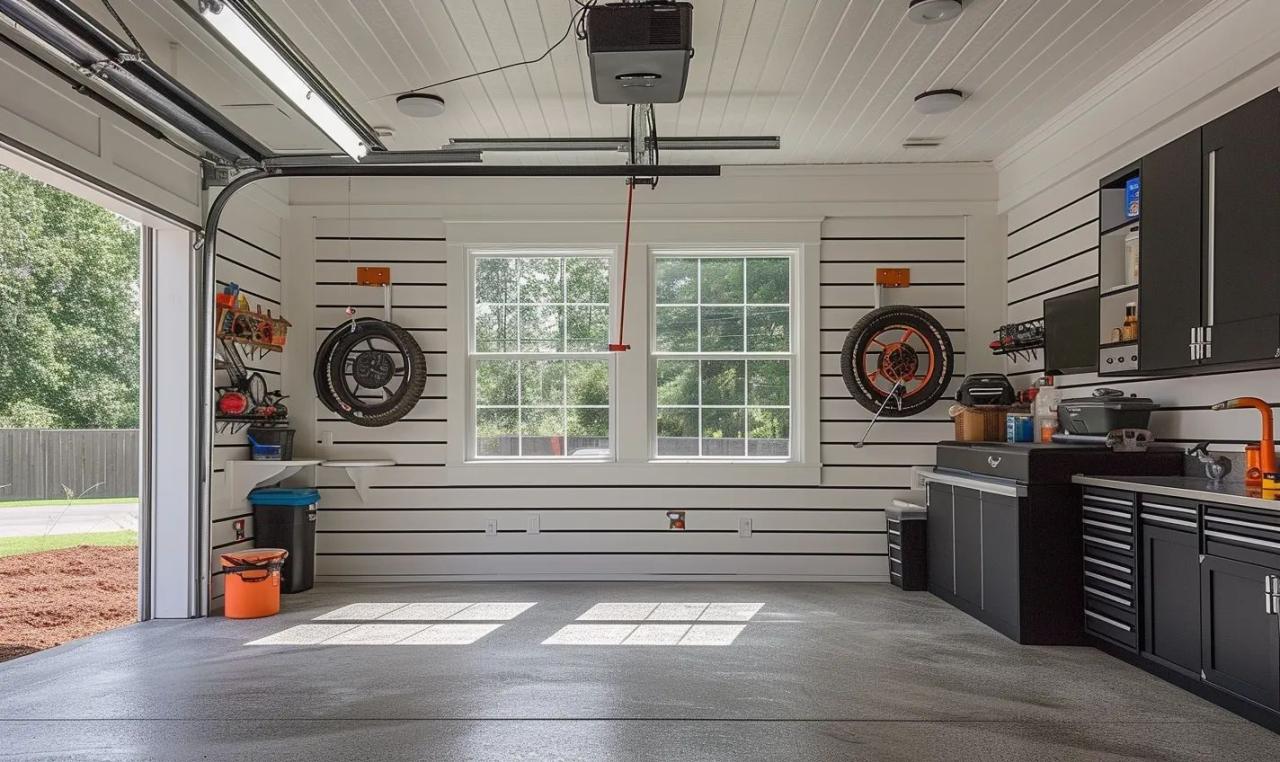
Incorporating natural light can significantly affect the space’s aesthetics and functionality when designing your indoor garage lighting. Natural light enhances visibility and creates a more inviting and pleasant environment. Maximizing natural light can reduce energy consumption, improve safety, and create a more enjoyable working or recreational space. Here are some tips to help you bring natural light into your garage:
Assessing Your Garage’s Natural Lighting Potential
Before making any changes, evaluating your garage’s natural lighting potential is essential. Take note of the garage’s orientation, windows, skylights, and existing light sources to understand how light enters the space throughout the day. This assessment will help you identify areas that need improvement.
Maximizing Daylight with the Right Window Placement
The strategic placement of windows can significantly enhance the natural light in your garage. Consider placing windows on walls that receive the most sunlight during the day. South-facing windows tend to receive the most light, while north-facing windows may result in less direct sunlight. East and west-facing windows can offer a balance between natural light and heat gain.
Choosing the Right Window Types for Your Garage
When selecting windows for your garage, opt for ones that maximize the amount of natural light entering the space. Consider large, energy-efficient windows with low-E glass to reduce heat transfer and UV radiation. Additionally, windows that are easy to clean and maintain will ensure that the natural light isn’t obstructed by dirt or grime.
Enhancing Natural Light with Garage Door Windows
Another way to introduce natural light into your garage is by incorporating windows into your garage door. Garage door windows can be placed strategically to allow light to enter from different angles. This option increases the amount of natural light and offers a visually appealing design element.
Utilizing Skylights to Bring in More Daylight
Skylights are an excellent alternative if windows aren’t possible or sufficient for your garage. Skylights can provide ample natural light and create an open and airy ambiance. Ensure proper sizing and placement of skylights to maximize daylight while minimizing potential heat gain or loss.
By incorporating these strategies, you can optimize the natural light in your garage and transform it into a bright, welcoming space. Remember to assess your garage’s natural lighting potential, strategically placed windows and skylights, choose the suitable window types, and consider garage door windows. With these tips, you can enjoy the benefits of natural light while enhancing your indoor garage’s overall functionality and appeal.
Enhancing Natural Light with Garage Door Windows

Garage door windows are a fantastic way to incorporate natural light into your garage. They not only brighten up the space but also create a welcoming and visually appealing atmosphere. By strategically adding windows to your garage door, you can maximize the daylight that enters, reducing the need for artificial lighting during the day.
Here are some tips on how to enhance natural light with garage door windows:
Positioning the Windows
Consider the placement of your garage door windows carefully. Optimal positioning can significantly affect the amount of light that enters the space. Placing windows at eye level allows natural light to flood the garage, providing ample brightness and visibility.
Choosing the Right Window Types
When selecting windows for your garage door, consider the type of glass and the design aesthetic you want to achieve. Insulated glass is an excellent option, enhancing energy efficiency while allowing natural light to stream in. Frosted or tinted glass can provide privacy while still allowing light to enter.
Accessorizing with Window Treatments
Window treatments are not only for the interior of your home; they can also be used in your garage. Adding blinds or curtains to your garage door windows lets you control the amount of light that enters. This is particularly useful if you use your garage as a workshop or a space for delicate items that need protection from direct sunlight.
Safety and Security
While incorporating windows into your garage door is a great way to enhance natural light, it’s essential to consider the safety and security aspects. Opt for laminated or tempered glass to ensure durability and minimize the risk of break-ins. Additionally, install reliable locks and security systems to keep your garage and belongings safe.
Maintaining and Cleaning Windows
To maximize the benefits of natural light, it’s crucial to keep your garage door windows clean and well-maintained. Regularly clean the glass with a mixture of mild detergent and water. Avoid using harsh chemicals that may damage the glass. Additionally, inspect the sealants and weatherstripping around the windows to ensure they are in good condition.
You can transform your garage into a naturally illuminated space by incorporating garage door windows. The proper placement, type of glass, and window treatments can enhance your garage’s overall aesthetics and functionality. Embrace the beauty of natural light and enjoy its many benefits to your garage.
Utilizing Skylights to Bring in More Daylight
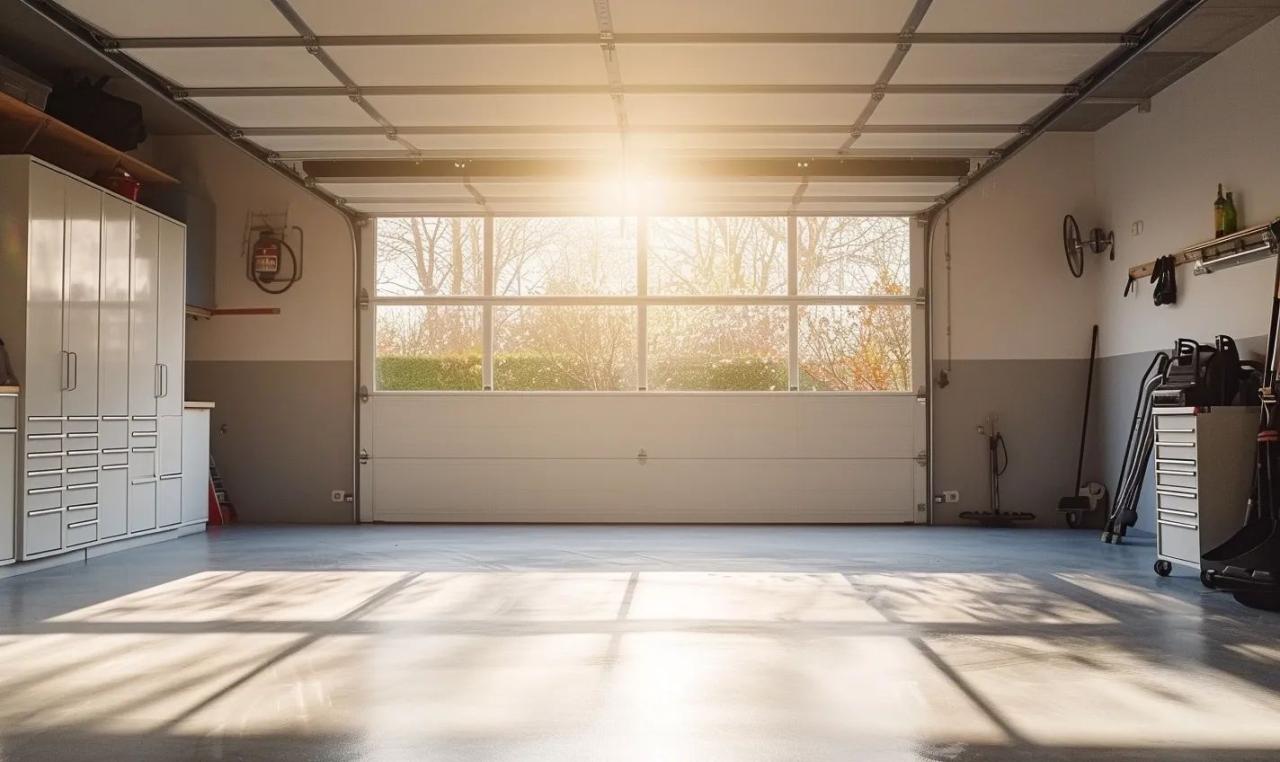
When it comes to incorporating natural light into your garage, skylights are a fantastic option. They effectively bring in the beautiful sunlight from above, illuminating your space and reducing the need for artificial lighting during the day.
Why Choose Skylights?
Skylights offer several benefits for your indoor garage lighting design:
- Increased natural light: Skylights capture sunlight directly from above, spreading it evenly throughout your garage.
- Aesthetically pleasing: These windows on your roof create a visually appealing and unique feature, adding a touch of elegance to your space.
- Energy efficiency: Using skylights can reduce reliance on artificial lighting during the day, leading to potential energy savings.
- Improved ventilation: Some skylights can open and close, allowing fresh air to circulate in your garage.
Placement and Size Considerations
When incorporating skylights, consider the placement and size of these windows to maximize their effectiveness:
- Location: Install skylights where they can capture the most sunlight, typically on the roof’s southern or southeastern side.
- Size: Ensure that the skylights are proportionate to the size of your garage. Adequately sized windows will provide ample natural light without overwhelming the space.
- Regulations: Check local building codes and regulations to ensure compliance when cutting holes in your garage roof for skylights.
Selecting Skylight Features
When choosing skylights, several features can enhance their functionality and convenience:
- Glazing: Opt for low-emissivity or solar-reflective glazing for improved thermal insulation and reduced heat gain.
- Ventilation options: Consider skylights with motorized or manual opening mechanisms to allow for natural airflow when desired.
- Shades or blinds: Install shades or blinds to control the sunlight entering your garage, especially during hot summer.
- Additional accessories: For convenience, explore options like rain sensors and remote control operation.
By embracing skylights as part of your indoor garage lighting design, you can bring in abundant natural light, creating a bright and inviting space. Consider their placement, size, and features to achieve optimal functionality and visual appeal in your garage.
Considerations for Optimal Garage Lighting
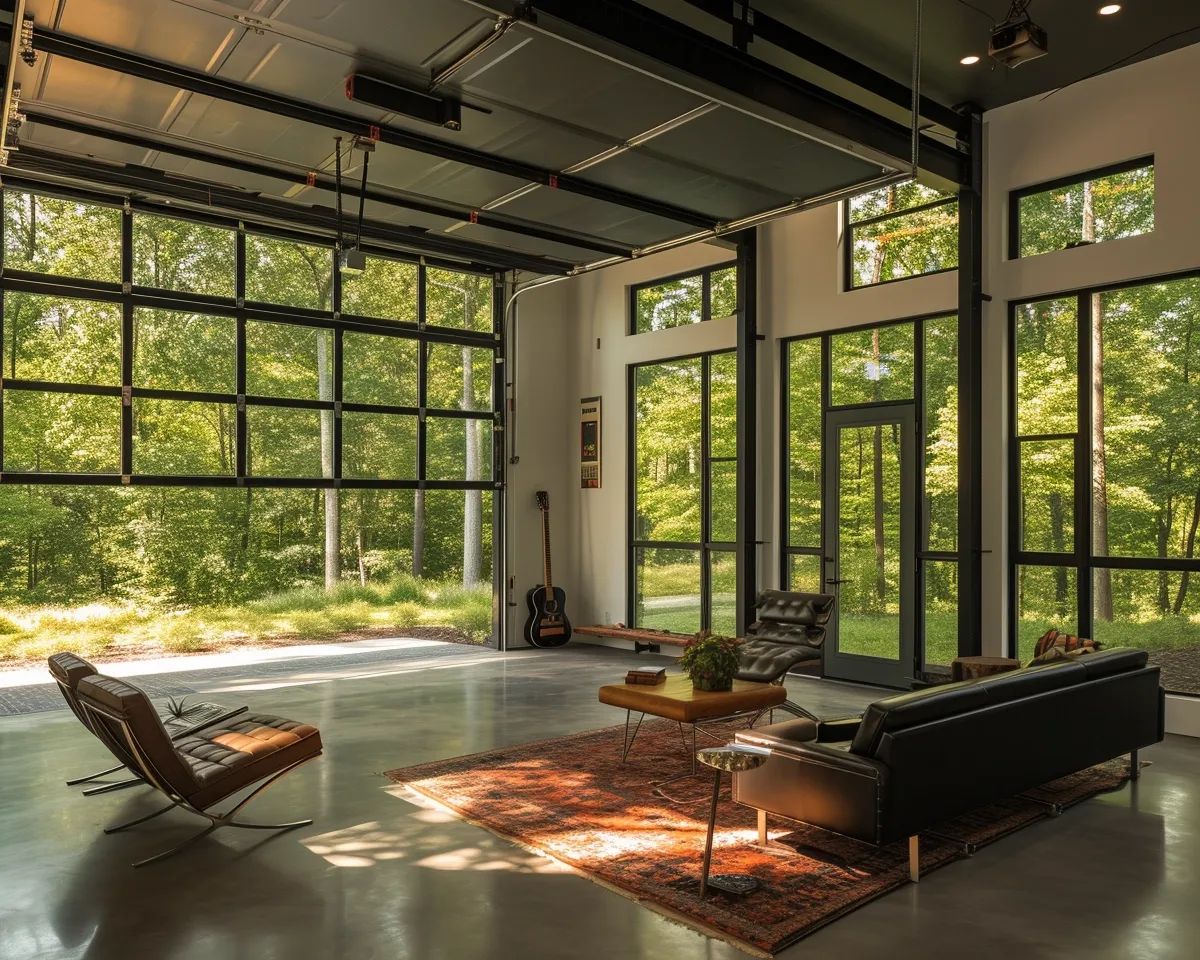
When designing your indoor garage lighting, several key considerations must be remembered. Considering these factors, you can create a well-lit, inviting space incorporating natural light. Here are some essential things to consider:
Balance natural and artificial light
While natural light is essential for a bright and airy garage, having a reliable source of artificial lighting is also necessary. This helps ensure your garage is well-lit during nighttime or overcast days. Combining natural and artificial light ensures optimal daylight throughout the day.
Optimize window placement
Choosing the correct window placement can significantly impact the amount of natural light that enters your garage. Consider the orientation of your garage and identify the areas where natural light is most likely to enter. This will help you determine the ideal spot to install windows for maximum daylight penetration.
Select the right window types.
The type of windows you choose for your garage can also make a difference in how much natural light you can harness. Options, like fixed, casement, or awning windows, are excellent choices, as larger glass areas allow more light to enter. Additionally, consider windows with low-E glass to decrease heat transfer and maintain a comfortable temperature in your garage.
Consider garage door windows.
Consider incorporating windows into the design if your garage has a roll-up or sectional door. Garage door windows bring in natural light and add visual appeal to your garage. They provide a seamless integration with your garage door, allowing even more natural light to flood the space.
Utilize skylights
Skylights are an excellent way to introduce natural light into your garage while preserving wall space for storage. They can be strategically placed to bring in ample daylight and create the illusion of an open and expansive environment. Consider utilizing skylights to maximize the natural light in your garage.
By implementing these considerations, you can incorporate natural light into your garage and create an optimal lighting solution that meets your needs. Remember, a well-lit garage enhances visibility and functionality and promotes a pleasant and inviting atmosphere.
Using Mirrors and Reflective Surfaces to Amplify Light
When designing the lighting in your indoor garage, incorporating natural light should be a top priority. Not only does natural light create a more inviting and enjoyable space, but it also helps to reduce the need for artificial lighting during the day. One effective way to maximize your garage’s natural light is by strategically using mirrors and reflective surfaces.
Why Mirrors and Reflective Surfaces Matter
The reflective properties of mirrors and other surfaces can significantly enhance the natural light in your garage. By strategically placing mirrors and reflective panels, you can bounce natural light further into the space and create a brighter, more open atmosphere. This simple addition can make your garage feel larger and more spacious without extensive renovations.
Placement and Orientation
To make the most of mirrors and reflective surfaces, consider these helpful tips:
- Position mirrors opposite windows or other natural light sources to reflect and amplify the incoming light.
- Angle mirrors to redirect light in darker corners or areas with limited natural light.
- Place mirrors near light-colored walls or ceilings to bounce light around the room.
By strategically placing mirrors in these ways, you can create a harmonious balance of natural light in your garage, eliminating darker areas and ensuring a well-lit space throughout the day.
Choosing the Right Reflective Surfaces
In addition to mirrors, other reflective surfaces can amplify natural light in your garage. Consider incorporating the following options:
- Glossy or metallic finishes on walls or cabinets to bounce light.
- Polished concrete or epoxy flooring to reflect and brighten the space.
- Chrome or stainless steel fixtures to add reflective elements.
These reflective surfaces can help scatter and disperse natural light, illuminating your garage more effectively.
Remember, avoid creating excessive glare or bright spots when using mirrors and reflective surfaces. Balancing the placement and amount of reflection will ensure a comfortable and enjoyable environment.
By incorporating mirrors and reflective surfaces into your garage design, you can amplify the natural light, create a brighter atmosphere, and reduce dependency on artificial lighting during the day. Embrace the potential of natural light and transform your garage into a welcoming space you’ll love spending time in.
The Importance of Light Colors and Finishes
Regarding garage lighting, one aspect often overlooked is the importance of light colors and finishes. The colors and finishes you choose for your garage space can significantly impact how well natural light is utilized and reflected throughout the area. Here’s why it matters:
Reflectivity Matters:
Choosing light-colored walls and finishes is essential for maximizing the natural light in your garage. Light colors have higher reflectivity, meaning they bounce more light around the space, making it feel brighter and more open. On the other hand, dark colors absorb light, making your garage appear gloomy and less inviting.
Creating Depth and Contrast:
Opt for various light-colored finishes in your garage to create depth and contrast. Using lighter shades on the walls and flooring can make the space feel more spacious and well-lit. Additionally, consider incorporating reflective surfaces like glossy tiles or polished concrete to enhance the impact of natural light further.
Preventing Glare:
While natural light is desirable, excessive glare can be a problem. To mitigate this issue, consider using matte finishes on walls and floors to help diffuse the light and minimize reflections. This will create a softer and more evenly distributed light in your garage, making it easier on the eyes and enhancing visibility while working on projects.
Complementing Aesthetics:
Light colors and finishes not only enhance the functionality of your garage but also complement its overall aesthetics. Neutral and light tones create a clean and modern look, allowing your garage to seamlessly blend with the rest of your home’s interior design.
Quick Tips:
- Choose light-colored paint or wall coverings for your garage walls.
- Opt for light-colored flooring materials, such as light tiles or epoxy coatings.
- Consider using glossy or polished finishes to increase reflectivity.
- Avoid dark or overly bright colors that absorb or reflect too much light.
- Use matte finishes to reduce glare and create a softer light.
By paying attention to light colors and finishes in your garage, you can optimize the natural light available and create a more pleasant and functional environment. So, when designing your indoor garage lighting, remember that the colors and finishes you choose play a vital role in harnessing and maximizing the benefits of natural light.
Selecting the Right Light Fixtures for Your Garage
Once you have assessed and optimized the natural light sources in your garage, it’s time to consider the artificial lighting options. Proper lighting is crucial to ensure your garage is well-lit and functional during the evenings or on cloudy days when natural light is limited. Here are some factors to consider when selecting the right light fixtures:
LED Lights for Energy Efficiency
Did you know? LED lights are up to 80% more energy-efficient than traditional incandescent bulbs.
LED lights are your best bet for saving energy and reducing electricity bills. These lights consume significantly less electricity and have a longer lifespan than other bulbs. Opting for LED light fixtures in your garage lets you illuminate the space effectively while minimizing environmental impact.
Brightness and Color Temperature
Consider the brightness level and color temperature of the light fixtures you choose for your garage. A good rule of thumb is to aim for a neutral white light (around 4,000-5,000 Kelvin) as it closely resembles daylight. This color temperature enhances visibility and helps create a welcoming and productive atmosphere in your garage.
Placement and Coverage
Proper placement of light fixtures is essential to ensure even coverage throughout your garage. Installing lights in strategic locations such as the ceiling, workbench area, and storage spaces will help eliminate shadows and provide ample illumination for various activities. Remember to prioritize your garage’s functional areas and adjust the fixture placement accordingly.
Motion-Activated Lighting
Consider installing motion-activated lights in your garage for added convenience and energy savings. These fixtures will automatically turn on when motion is detected and off when no movement is detected for a specified period. With motion-activated lighting, you won’t have to worry about accidentally leaving lights on and wasting electricity.
Task Lighting for Specific Activities
If you have specific tasks that require focused lighting, such as woodworking or car maintenance, consider incorporating task lights into your garage design. Task lights are adjustable and provide concentrated light where you need it most. This not only enhances visibility but also reduces eye strain during detailed activities.
By carefully considering these factors and selecting the right light fixtures for your garage, you can create a well-lit space that meets your needs and enhances productivity. Don’t forget to combine your artificial lighting choices with the natural light optimization strategies discussed earlier, as merging both sources will provide the best possible lighting solution for your garage!
Incorporating Natural Light into Garage Organization
When it comes to designing your indoor garage lighting, there is one aspect that often gets overlooked – incorporating natural light. Natural light not only enhances the aesthetics of your garage but also provides numerous benefits for organization and functionality. Let’s explore ways to bring in natural light to optimize your garage space.
Amplify natural light with windows and skylights.
Windows and skylights are excellent sources of natural light that can transform the ambiance of your garage. Consider the following tips:
- Assess your garage’s layout and determine the optimal window and skylight placement to maximize daylight penetration.
- Choose the right window types based on your preferences and garage design. Casement, awning, or sliding windows are popular choices.
- Enhance natural light by installing windows on your garage doors. This not only adds brightness but also enhances the overall visual appeal.
- Utilize skylights strategically to bring in additional daylight. They work exceptionally well in garages with limited wall space for traditional windows.
Utilize reflective surfaces and light colors.
Make the most of the natural light you have by incorporating reflective surfaces and light colors into your garage’s interior:
- Use mirrors strategically to amplify the amount of light in your garage. Place them across from windows or skylights to bounce light around the space.
- Opt for light-colored walls and finishes to maximize the reflection of natural light. Light shades of paint or epoxy floor coatings can make a significant difference.
Consider functional lighting fixtures.
While natural light is essential, having functional lighting fixtures for tasks requiring extra illumination is crucial. Keep the following points in mind:
- Select energy-efficient LED fixtures that provide sufficient brightness without consuming excessive electricity.
- Install task lighting above workbenches, tool areas, and storage spaces to ensure optimal working visibility.
- Consider motion-sensor lights near entranceways or within walk-in closets for added convenience and safety.
Incorporating natural light into your garage organization will create a brighter, more inviting space that enhances functionality and aesthetics. So, take advantage of windows, skylights, reflective surfaces, and well-placed lighting fixtures to optimize your garage for various activities.
Remember, a well-lit garage improves visibility and enhances your overall experience. So, get creative and brighten up your garage with natural light!
Additional Tips for Bringing Natural Light into Your Garage
Bringing natural light into your garage is not only a practical choice but also adds a touch of warmth and brightness to the space. If you’ve already explored various ways to incorporate natural light into your garage, here are a few additional tips to enhance the effect:
Install a Sun Tunnel
Consider installing a sun tunnel if your garage doesn’t have direct access to natural light. These daylighting systems capture sunlight on your roof and redirect it into your garage through a reflective tube, allowing natural light to enter even when windows or skylights aren’t feasible.
Light-Transmitting Panels
Another option for introducing natural light into your garage is to install light-transmitting panels. These panels are made from translucent materials, such as polycarbonate, and can be installed in sections of your garage’s roof or walls. They allow natural light to filter in while still maintaining privacy.
Reflective Flooring
Maximize the effects of natural light in your garage by opting for reflective flooring surfaces. Choose materials like polished concrete or epoxy coatings that help bounce light around the space, making it feel brighter and more spacious.
Use Light Colors
When painting your garage, opt for light, neutral colors to help reflect and amplify the natural light. Light-colored walls, ceilings, and garage doors will make the space appear brighter and more welcoming.
Clean and Maintain Windows
Regularly clean and maintain your garage windows to ensure they allow ample natural light into the space. Dirty or grimy windows can obstruct sunlight and minimize the benefits of natural light. Wipe them down periodically and ensure the seals are intact to prevent drafts.
By incorporating these additional tips into your garage design, you can significantly enhance the natural light in your space. Remember, natural light improves visibility and energy efficiency and contributes to your garage’s overall ambiance and functionality.
Natural Light into Your Garage
Natural light should be a top priority when designing your indoor garage lighting. Natural light not only brightens up the space, making it more inviting and pleasant to spend time in, but it also has various benefits for your physical and mental well-being. Here are some tips to help you harness the power of natural light in your garage:
Assessing Your Garage’s Natural Lighting Potential
The first step in natural light into your garage is to assess its current lighting setup. Note any existing windows, skylights, or other natural light sources. Consider the placement and size of these openings and their orientation to the sun throughout the day. This will help you determine where natural light is most readily available, and adjustments may be needed.
Maximizing Daylight with the Right Window Placement
If your garage has no windows or lacks sufficient natural light, consider installing windows strategically to maximize daylight entry. Placing windows on walls facing the south or east is ideal, as these orientations receive the most sunlight during the day. Additionally, avoid placing windows on walls obstructed by trees, buildings, or other structures that may block the sunlight.
Choosing the Right Window Types for Your Garage
When selecting windows for your garage, consider both aesthetics and functionality. Opt for windows that allow ample natural light to enter the space while providing proper insulation and security. Double-pane windows are a great option as they help regulate temperature and minimize outside noise.
Enhancing Natural Light with Garage Door Windows
Incorporating windows in your garage doors is another effective way to bring in natural light. Garage door windows not only maximize daylight but also add visual appeal to the exterior of your garage. Choose from various styles and sizes to suit your garage’s overall design.
Utilizing Skylights to Bring in More Daylight
If adding windows to your garage walls is not feasible, consider installing skylights on the roof. Skylights allow natural light to illuminate the garage’s interior without compromising wall space. They can be instrumental if you have limited wall space due to storage or equipment.
By incorporating natural light into your garage, you can create a brighter, more inviting space while reaping the benefits of increased natural daylight. Consider these tips and features when designing your indoor garage lighting to enhance your garage’s aesthetic and functionality.
Conclusion
I hope this blog post has shed some light on the importance of incorporating natural light into your garage and provided you with practical design tips to enhance the brightness and functionality of this space. Maximizing natural light can transform your garage into a more inviting, energy-efficient, and versatile area.
Remember, when it comes to garage lighting, a combination of artificial and natural light sources can create a well-lit and comfortable environment. So, don’t hesitate to explore different options, such as skylights, windows, and glass doors, to let in ample sunlight during the day.
Furthermore, consider using light-colored paints for the walls and ceiling to reflect natural light and distribute it throughout the garage. Utilizing reflective surfaces and strategically placing mirrors can also help bounce natural light into the darker corners.
Lastly, don’t overlook the benefits of proper window coverings and insulation. These elements can help regulate the temperature, prevent unwanted heat transfer, and reduce glare while allowing natural light to penetrate your garage.
By incorporating these design tips into your garage, you can save on energy costs and create a welcoming and functional space for various activities. So get creative, consider how to make the most of natural light, and enjoy its benefits to your garage.
Frequently Asked Questions (FAQs)
Q: How can I incorporate natural light into my garage?
A: There are several ways to incorporate natural light into your garage. You can install windows or skylights, use translucent doors or panels, or even add a glass garage door for maximum natural light.
Q: What are the benefits of incorporating natural light into my garage?
A: Natural light can improve visibility in your garage, reduce the need for artificial lighting during the day, create a more pleasant and inviting atmosphere, and even provide some vitamin D benefits.
Q: Can I still have natural light in my garage without windows or skylights?
A: Alternative methods exist to bring natural light without windows or skylights. Consider using translucent doors or panels or installing a glass garage door for maximum natural light exposure.
Q: Are there any downsides to incorporating natural light into my garage?
A: While natural light can be beneficial, it may also increase the temperature and humidity in your garage. Additionally, depending on the sun’s position, it may not provide consistent lighting throughout the day.
Q: How can I control the amount of natural light in my garage?
A: To control the amount of natural light, you can use window treatments, such as blinds or curtains, install adjustable skylights, or choose a glass garage door with built-in shading options.
Q: Will incorporating natural light into my garage increase energy costs?
A: In general, incorporating natural light can help reduce the need for artificial lighting during the day, resulting in energy savings. However, the impact on energy costs will depend on various factors, such as insulation and the overall design of your garage.